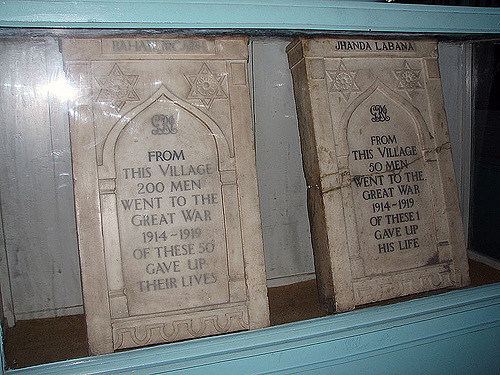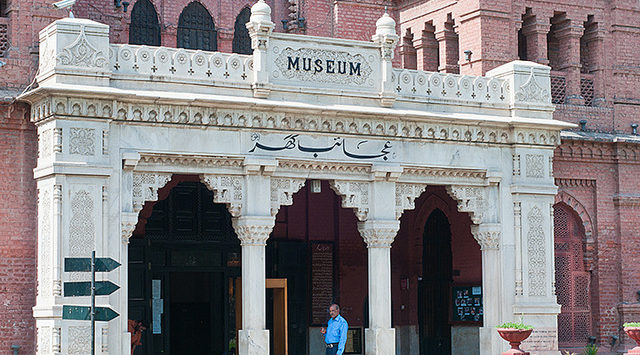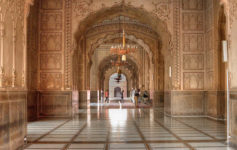Lahore is one of the world’s greatest ancient cities. For at least 2,000 years this northeastern city in Pakistan has been a center of learning for scholars, poets, and mystics. To better understand the long history of this city, it’s a good idea to start your tour of Lahore in the city’s cherished museum.
The Lahore Museum (Urdu: لاہور عجائب گھر) is the largest museum in all of Pakistan. Founded in 1864 by the British Raj, this museum has a huge collection of artifacts, artworks, weapons, and even costumes from many South Asian nations. It’s only about a 15-minute drive to get from the Walled City of Lahore to the Lahore Museum. The Lahore Museum is in the Mall area of the city across the street from the Punjab University Allama Iqbal Campus.

Although this museum was built during the British occupation of Lahore, the main building was built using design patterns from the Mughal Empire. You certainly won’t miss the main redbrick building with its large domes and columns.
At first, this museum was actually set up in a date garden on Wazir Khan’s pavilion around 1855. After Lahore’s collection began to expand, museum organizers realized they needed a larger space to put all of their precious artifacts. So, during the Punjab Exhibition of Industrial Arts and Crafts in 1864, museum curators moved their treasures to what was then known as the Tollinton Market. Today this building is called the Lahore Central Museum.

It wasn’t until 1861 that the Lahore Central Museum started receiving rare objects from all around Southern Asia. Major archeological digs were going on during this time in Harappa that uncovered amazing items from both the Indus Valley and the Gandhara Civilizations. This is the first time the museum took in objects that weren’t from the local area.
John Lockwood Kipling, the father of Jungle Book author Rudyard Kipling, became the head curator of the Lahore Central Museum in 1875. He also taught at the nearby Mayo School of Art. Kipling was a strong supporter of the museum and helped Lahore collect a ton of artifacts from all around Southern Asia.
In 1887, Kipling and other members of the Lahore Museum decided to start a fundraising campaign to build a larger museum. Once they reached the requisite funds, the Lahore Museum staff invited Queen Victoria’s grandson Prince Albert Victor to visit Lahore in 1890. Prince Victor agreed and laid the first stone in what was to become the modern Lahore Museum. It only took four years to complete this ornate museum complex that measures 27,850 square feet. Kipling retired just one year before the new Lahore Museum opened its doors to the public.

As you walk into the entrance gallery, you can’t help but stare at the huge ceiling painting entitled “The Evolution of Mankind.” The famed Pakistani artist Syed Sadequain Ahmed Naqvi (better known as Sadequain) painted this 100 by 35 feet mural between 1973 and 1974. Local government authorities have recently put a great deal of money into restoring Sadequain’s masterpiece to its former glory. You’ll also find a few pieces of calligraphy by Sadequain in the museum’s Islamic Gallery.
As you’d expect, the Lahore Museum has an extremely rich collection of Mughal and Sikh artwork. Interestingly, however, this museum’s most prized item is a statue of an emaciated Buddha. In Buddhist lore, Prince Siddhartha Gautama (the future Buddha) spent many years practicing severe austerities in his quest for Enlightenment. Once he discovered this training wasn’t leading him towards peace, Gautama decided to eat a good meal and regain his strength. With his body restored, Gautama sat under the Bodhi Tree, meditated on his breath, and was soon liberated from the cycle of birth and death (aka samsara). The statue in the museum, officially called the Fasting Buddha, shows and extremely thin Gautama during the time he practiced fasting. Historians place this statue in the Gandhara period of history.

Besides the Fasting Buddha, this museum has a wide assortment of Buddhist and Hindu objects from many Asian nations. Most of the artwork on display is either from the 19th or 20th century, but a few items date back to the 8th century. Besides India, there are quite a few items from countries like Burma, Nepal, and Tibet.
The oldest objects in this museum go back 500,000 years. Visitors can marvel over stone artifacts like tools and religious objects in the Pre & Proto-Historic area. A few important items discovered and donated to the museum by British archeologists include measuring weights, pottery, and even terracotta jewellery. These pre-historic items remind visitors just how far back Lahore’s history stretches back.
People interested in coinage will find a wide variety of coins on display in Lahore Museum. Believe it or not, the Lahore Museum now has 40,000 coins from all over Southern Asia, some of which date back to the 6th century. Check out how civilizations like the Mauryan, Indo-Parthian, Hun, Arabs, Sikhs, and Mughals did business all those years ago!
A few other popular exhibits in this museum include an ancient and modern weaponry area, a postage stamp collection, a hall with Islamic art and calligraphy, and a gallery with miniature paintings.

But Lahore Museum isn’t just about ancient relics. There are many sections of the museum dedicated to telling the story of modern Pakistan. Check out the Contemporary Paintings gallery to see some of the greatest examples of modern Pakistani art. Just a few great Pakistani artists who’ve left pieces in Lahore Museum include Ghulam Rasool, Asit Kumar Haldar, Shakir Ali, and Jamil Naqash.
There’s also a gallery in the Lahore Museum dedicated to telling the story of the Pakistan Movement. This area of the museum focuses on the historical period between 1757 and 1947. You’ll learn everything you need to know about the glories and trials of modern Pakistan through the many historical photographs here.

In addition to the main museum complex, the Lahore Museum has a cafeteria, a bookshop, and an auditorium. Specialists can gain access to the museum’s world-renowned library, which has thousands of rare manuscripts. The museum does host a few events throughout the year, so be sure to check out what’s going on here during your visit. Foreigners will be charged 400 Pakistani Rupees to enter Lahore Museum.
(*) Photo Credits:





